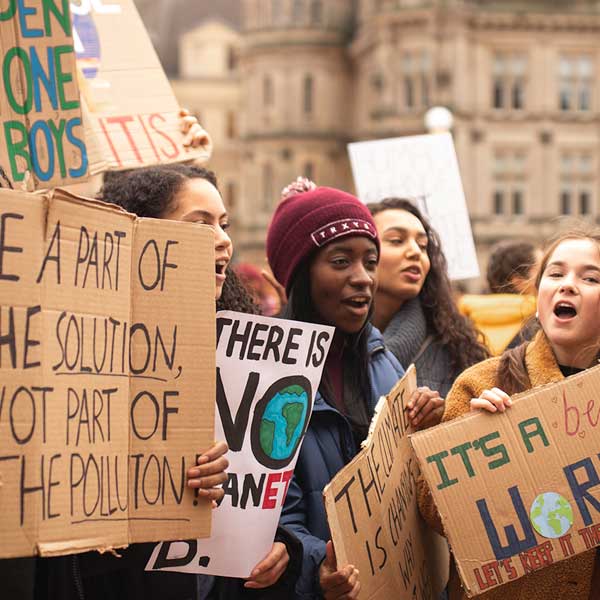
Sustainability
Today's students will grow up to be the leaders who are tasked with building sustainable, equitable societies in an interconnected and interdependent world. To prepare them, today's educators need to teach the concepts of sustainability and social justice in an era overloaded with often conflicting media messages. Equally important, we need to foster in our students the day-to-day civics skills and emotional intelligence that will make it possible for them to co-create a thriving future
We consider sustainability to be a central issue of our time. For this reason, we have created a rich collection of materials related to topics such as climate change, water, food and agriculture.
“Project Look Sharp’s professional development trainings and curriculum materials are “the most comprehensive media and sustainability curricula available.”
- Antonio Lopez, Greening Media Education: Bridging Media Literacy with Green Cultural Citizenship
You will find over 80 free lessons if you search our resources using the keyword "Sustainability". Further narrow your search by grade level or subject or filter by standard, media type, etc. Below we have highlighted a small number of lessons that use different approaches to the integration of media literacy and critical thinking into teaching about sustainability.
Our trainers can custom design a media literacy workshop or class using Sustainability
focused lessons, classroom videos and materials chosen specifically for your audience.
We also offer a workshop or class for teaching challenging topics through media analysis.
You will find dozens of free lessons if you search our resources using the keyword "Justice". Further narrow your search by grade level or subject or filter by standard, media type, etc.
Below we have highlighted a small number of lessons that use different approaches to the integration of media literacy and critical thinking into teaching about social justice content..
Our trainers can custom design a media literacy workshop or class using Social Justice
focused lessons, classroom videos and materials chosen specifically for your audience.
We also offer a workshop or class for teaching challenging topics through media analysis.
Today we are acutely aware of the need for students to develop habits of critical analysis, and evaluation of all media messages, including political messages that may be inaccurate or misleading. We need to teach our students, of all ages, the habit of asking key questions, such as: Who produced this for what purpose? Is the information accurate and current and the source credible? What are the biases, what is left out? How do my own biases impact my interpretation of this message and the credibility of the source? Habits only develop through consistent and reinforced practice. Project Look Sharp’s resources enable educators to integrate media analysis into the curriculum at all grade levels and subject areas – through asking subject area and critical thinking questions of rich media documents linked to core standards.
"I wish that I had these materials available when I was in school. They bring politics alive and make presidential campaigns relevant."
- Bill Moyers, journalist and founder of Public Affairs Television
If you search our resources you will find dozens of lessons related to media bias and credibility. You can narrow your search by grade level or subject or filter by standard, media type, etc.
Below we have highlighted a small number of lessons that use different approaches to the integration of media literacy and critical thinking into teaching about media bias and credibility.
We offer a workshop titled Truth, Lies and Metacognition: Integrating News Literacy into the Curriculum that provides guidelines and strategies for training our students to not only assess the credibility, accuracy, and bias of various news sources, but also to reflect on their interpretations and build their capacity to meaningfully take action online and in their communities.
Learn MoreIn February 2020 the World Health Organization named a new kind of media consumption ailment, “a massive ‘infodemic’ - an over-abundance of information – some accurate and some not – that makes it hard for people to find trustworthy sources and reliable guidance when they need it.” In response to, the pandemic, the Infodemic and the related shift to digital learning for schools around the world, Project Look Sharp has complied a series of new resources. These include many new lessons focused on coronavirus and the Infodemic, print and video resources for teaching media decoding online, and other resources for doing classroom media decoding in the time of Covid-19.
Tips for Online Learning Using Look Sharp materials
We offer a workshop titled Truth, Lies and Metacognition: Integrating News Literacy into the Curriculum that provides guidelines and strategies for training our students to not only assess the credibility, accuracy, and bias of various news sources, but also to reflect on their interpretations and build their capacity to meaningfully take action online and in their communities.
Learn More
Social Justice
We have a long-standing commitment to developing materials and trainings related to social justice concerns. For this reason, we have created a rich collection of materials related to topics such as economics and equity, the history of peace and social justice movements and the life of Dr. Martin Luther King, Jr.
“Project Look Sharp curricula does not preach, but by asking provocative questions it leads students to think carefully and re-examine traditional ideas. In short, it fosters independent thinking, which, after all, should be the chief objective of a good education.”
- Howard Zinn, historian and author of “A People's History of the United States"